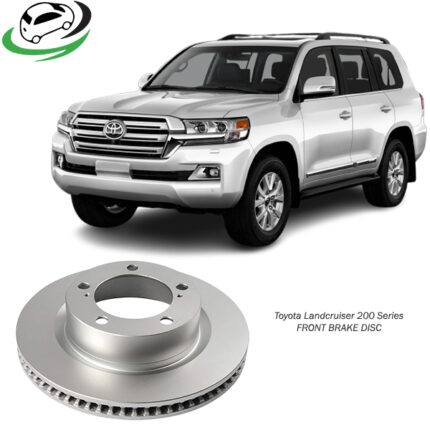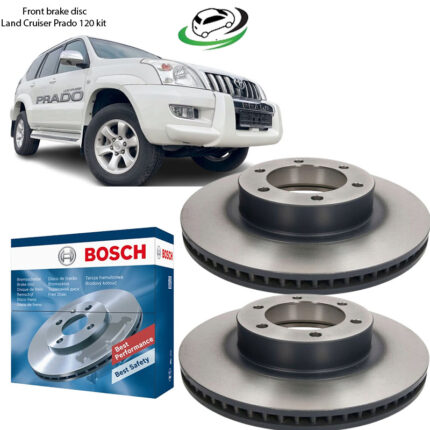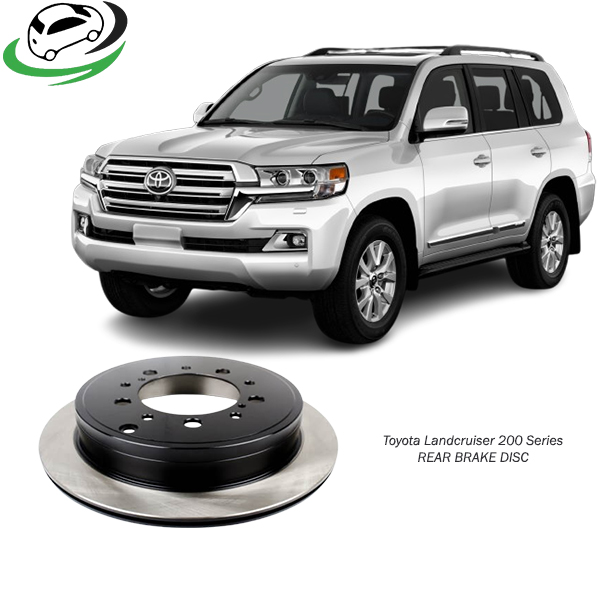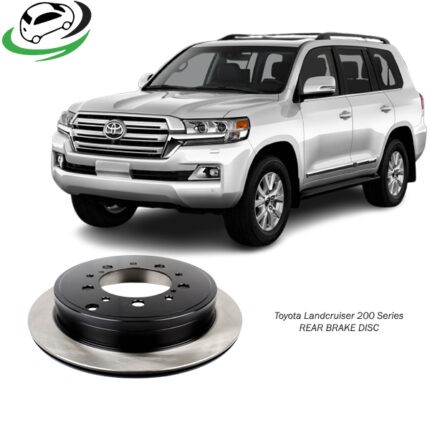Get Toyota Land Cruiser 200 Series Rear Brake Disc
The rear brake disc, also known as the rear brake rotor, is a crucial component of a vehicle’s braking system. It works in tandem with the brake pads, calipers, and hydraulic system to ensure efficient braking performance. Although front brakes usually handle a larger percentage of the stopping power due to weight distribution and momentum, rear brakes, particularly the brake discs, play an essential role in maintaining overall balance, stability, and safe braking performance.
This guide will explore the design, functions, types, benefits, maintenance, and common issues associated with rear brake discs, along with tips to help drivers make informed decisions about their vehicle’s brake system.
Design and Components of Rear Brake Discs
A rear brake disc is a circular metal component that rotates with the wheel. When the driver presses the brake pedal, hydraulic pressure is applied to the brake caliper, which pushes the brake pads against the spinning disc, generating friction that slows down the vehicle. Several components work together within the disc braking system:
- Brake Disc (Rotor):
- The rotor is usually made from cast iron or a composite of materials such as carbon-ceramic for high-performance vehicles. Its surface provides a flat area for the brake pads to press against and create friction. The design of the disc can vary, with some having vents or drilled holes to improve cooling.
- Brake Pads:
- Brake pads are made from friction materials that are pressed against the rotor’s surface to slow down or stop the vehicle. They wear over time and require periodic replacement.
- Brake Caliper:
- The caliper houses the brake pads and pistons. It applies pressure to the brake pads when the driver presses the brake pedal, causing them to press against the rotor.
- Hydraulic System:
- The hydraulic system consists of brake fluid, master cylinders, and hoses. This system transfers the force from the brake pedal to the caliper, enabling the brake pads to apply pressure on the disc.
Types of Rear Brake Discs
Rear brake discs come in different designs depending on the type of vehicle and its intended use. Here are the common types:
- Solid Brake Discs:
- Solid discs are the most common and basic type of rear brake discs. They are typically found in standard vehicles, where the braking demands are not as extreme. These rotors are solid pieces of metal, making them durable but less efficient at dissipating heat compared to vented or drilled discs.
- Vented Brake Discs:
- Vented discs have channels or grooves between the rotor’s two surfaces to allow air to flow through and cool the disc. These are more commonly found on performance or heavy-duty vehicles. Vented discs help reduce heat buildup and minimize the risk of brake fade during continuous or heavy braking.
- Drilled Brake Discs:
- Drilled discs have holes drilled through them to improve heat dissipation and help prevent gas buildup between the pad and rotor. They also provide better wet performance as the holes allow water to escape, improving braking efficiency in wet conditions. However, drilled discs can be prone to cracking under extreme conditions.
- Slotted Brake Discs:
- Slotted discs have grooves or slots machined into the surface. These slots help to scrape the brake pads, removing debris and gases that can reduce braking effectiveness. Slotted discs are more durable than drilled discs and are often used in performance or heavy-duty applications, such as in racing or off-road vehicles.
- Drilled and Slotted Brake Discs:
- Combining both drilling and slotting, these brake discs offer improved cooling, better heat dissipation, and enhanced performance. They are commonly used in high-performance vehicles or under extreme driving conditions.
Functions and Importance of Rear Brake Discs
While the front brakes carry a significant portion of the braking load, the rear brakes serve several critical functions:
- Stability and Control:
- Rear brakes help maintain vehicle stability during braking by evenly distributing braking force between the front and rear wheels. Without effective rear brakes, a vehicle can experience a nosedive or rear-end instability when the front brakes are heavily applied.
- Balanced Braking:
- In an ideal scenario, the braking force should be distributed across all four wheels. Rear brakes, including the discs, ensure that the car doesn’t rely solely on the front brakes, thereby extending the life of both front and rear components.
- Prevention of Oversteer:
- During braking in a turn or when decelerating suddenly, rear brakes help prevent oversteer by applying a controlled amount of force to slow the rear of the vehicle evenly.
- Parking Brake Function:
- On some vehicles, the rear brake disc is used in conjunction with the parking brake. When the parking brake is engaged, the rear brakes lock the wheels in place, preventing the car from rolling.
Maintenance of Rear Brake Discs
To ensure optimal braking performance and safety, rear brake discs require regular inspection and maintenance. Here are some important maintenance tips:
- Regular Inspection:
- Brake discs should be inspected during routine maintenance to check for signs of wear, cracks, or warping. Uneven wear on the disc can reduce braking performance and lead to safety concerns.
- Measuring Rotor Thickness:
- Over time, brake discs wear down and become thinner. Manufacturers specify a minimum thickness for rotors, and driving with brake discs below this thickness can result in reduced performance and increased risk of failure. If the discs are too thin, they should be replaced.
- Brake Pad Replacement:
- Brake pads wear out faster than discs. Regular replacement of the brake pads helps prevent excessive wear on the rotors. Worn-out brake pads can lead to metal-to-metal contact, damaging the disc’s surface.
- Resurfacing vs. Replacing:
- If the brake discs show minor wear or uneven surfaces, resurfacing (or turning) may be an option to restore their flat, smooth surface. However, if the discs are cracked, severely worn, or below the minimum thickness, replacement is necessary.
- Brake Fluid Check:
- Brake fluid plays a key role in transferring the braking force to the caliper. Ensure the brake fluid is at the correct level and change it as per the manufacturer’s recommendations. Contaminated or old fluid can affect braking performance.
- Avoiding Overheating:
- Excessive braking can cause the brake discs to overheat, leading to brake fade or warping. It’s important to avoid riding the brakes, especially during downhill driving or heavy traffic. Allow the brakes time to cool down when possible.
Common Problems with Rear Brake Discs
Like any mechanical part, rear brake discs can experience wear and problems over time. Here are some common issues:
- Warping:
- Excessive heat generated during braking can cause the brake disc to warp, leading to a pulsating sensation in the brake pedal and uneven braking. Warped discs often need to be replaced or resurfaced.
- Cracks:
- Cracks in the brake disc can occur due to thermal stress. Cracked rotors pose a serious safety risk and should be replaced immediately.
- Scoring and Grooves:
- Debris or worn brake pads can cause scoring or deep grooves in the disc’s surface. This can reduce braking effectiveness and increase brake pad wear.
- Rust and Corrosion:
- Rust or corrosion can form on the disc surface if the vehicle is exposed to moisture or road salt. While surface rust can often be cleared by driving and braking, deeper corrosion can damage the disc and reduce its performance.
- Brake Noise:
- Squealing or grinding noises when braking are often indicative of worn brake pads or damaged discs. These noises should not be ignored, as they signal that the brake system needs attention.
Replacement and Upgrades
Brake discs typically need replacement after a certain amount of wear, which varies based on driving conditions, braking habits, and vehicle type. When replacing brake discs, it’s crucial to:
- Choose high-quality, manufacturer-recommended parts.
- Ensure both sides of the axle are replaced simultaneously to maintain balanced braking.
- Consider upgrading to performance rotors (vented, slotted, or drilled) if the vehicle is used in demanding conditions such as towing, off-roading, or racing.
Conclusion
The rear brake disc is an essential component of a vehicle’s braking system, providing stability, balance, and reliable stopping power. Regular maintenance, timely replacement of worn components, and attention to potential issues like warping or cracks can ensure the brake system remains effective and safe. Whether you are driving in everyday conditions or pushing your vehicle in high-performance situations, keeping your rear brake discs in top condition is critical to your vehicle’s overall performance and safety.
Follow us on Facebook for more parts.




